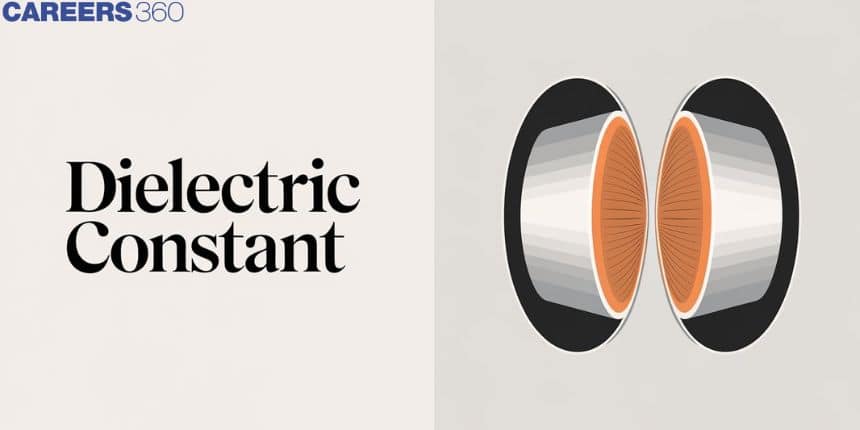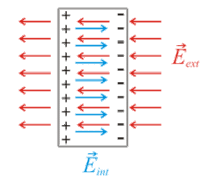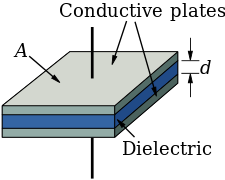Dielectric Constant - Definition, Formula, FAQs
Many things in our kitchen like ceramic cookware, glass, plastic and even air have a special property that we often ignore they can act as dielectrics. The dielectric constant tells us how these materials behave when placed in an electric field.It is closely related to ideas like permittivity and capacitance, which explain how materials can store and pass on electric energy. This simple concept is very important in electronics, electrostatics and material science.
This Story also Contains
- What is Dielectric Constant?
- What is Dielectric Constant Definition?
- What are dielectric constant units?
- Dielectric Constant Formula in terms of Permitivity
- Dielectric constant formula in terms of capacitance
- Factors Affecting Dielectric Constant:
- Application of dielectrics

What is Dielectric Constant?
The term "dielectric" refers to a substance with insulating qualities. It is a substance capable of transmitting electric force without conduction.
Many different types of electric and polarised materials have some combination property. You will come across several terminologies linked to dielectric and its applicability in today's real situations as you read this text. You'll also learn about unitless values and numbers that characterise how electric insulators behave when they're exposed to an electric field. Let’s learn the dielectric constant meaning.
What is Dielectric Constant Definition?
Dielectric constant, also known as relative permittivity or specific inductive capacity and it is ratio of capacitance of capacitor filled with particular material to capacitance of an identical capacitor in vacuum without dielectric material.
When a dielectric is introduced between the plates of a parallel-plate capacitor, the capacitance, or ability to store opposing charges on each plate, is always increased, compared to when the plates are separated by a vacuum.

The dielectric constant is represented by the Greek letter kappa, which is simply stated as $\mathrm{K}=\mathrm{C} / \mathrm{C}_0$. Here, C is the capacitance of a capacitor filled with a specific type of dielectric. And $\mathrm{C}_0$ is the capacitance of an identical capacitor in a vacuum.
Also read -
What are dielectric constant units?
The dielectric constant has no unit as it is the ratio of the same quantity (capacitance).
Here are some examples of dielectric constant values of various materials:
Dielectric Materials | Dielectric Constant Value |
The dielectric constant of vacuum | 1.00 |
The dielectric constant of air | 1.00059 |
The dielectric constant of water | 80.4 at 20 degrees Celcius. |
The dielectric constant of germanium | 16 |
| The dielectric constant of paraffin | 2.25 |
| The dielectric constant of glass | 5-10 at 20 degrees Celcius |
NCERT Physics Notes :
Define dielectric strength.
The ability of an insulating material to act as an insulator is known as dielectric strength. The highest electric field that an insulating material can withstand before dielectric breakdown and becoming electrically conductive is defined as its dielectric strength. The highest voltage required to create a dielectric breakdown in an electrically insulating substance is also known as dielectric strength.
Dielectric Constant Formula in terms of Permitivity
$
K=\frac{\varepsilon}{\varepsilon_0}
$
where,
$K=$ Dielectric constant (also called relative permittivity)
$\varepsilon=$ Permittivity of the material
$\varepsilon_0=$ Permittivity of free space $\left(8.85 \times 10^{-12} C^2 N^{-1} m^{-2}\right)$
Dielectric constant formula in terms of capacitance
The dielectric constant is the ratio of the capacitance produced by two metallic plates in the presence of an insulator to the capacitance of the same region in the absence of an insulator.

A low dielectric constant is required when a material is utilized for any insulating purpose.
The dielectric constant formula is as follows:
$
\mathrm{K}=\mathrm{C} / \mathrm{C}_0
$
$
\mathrm{C}_0=\varepsilon_0 \mathrm{~A} / \mathrm{t}
$
$\mathrm{C}=$ capacitance of the dielectric-capacitor material
$
\mathrm{C}_0=\text { capacitance of vacuum as dielectric. }
$
T is the sample thickness.
A is the plate's surface area.
$\epsilon_0=$ Free-space permittivity $8.85 \times 10^{-12} \mathrm{~F} / \mathrm{m}$
Relation between the dielectric constant and electric susceptibility.
The dielectric constant is a measurement of how well a material conducts electricity.
When a substance is held in an electric field, its electrical susceptibility determines how polarised it becomes. If the material becomes more polarised, it will create an internal field that opposes the external field, lowering the overall electric flux through it. As a result, the medium's electric permittivity is affected by its electric susceptibility.
The lower the electric permittivity, the higher the level of polarisation.
Factors Affecting Dielectric Constant:
- Frequency: At high frequency, molecules cannot align quickly, so dielectric constant decreases.
- Applied Voltage: DC voltage reduces dielectric constant, while AC voltage increases it.
- Temperature: Increasing temperature first increases dielectric constant (up to transition temperature) and then decreases it.
- Moisture/Humidity: More moisture increases dielectric constant but weakens the material.
- Heating Effect: Heating causes dielectric loss, where energy is wasted as heat.
Application of dielectrics
- Capacitors: Dielectrics increase capacitance by storing more electric charge.
- Insulators: Used to prevent current leakage in wires and electrical equipment.
- Oscillators & Tuned Circuits: Dielectrics help control frequency in radios, TVs, and communication devices.
- Energy Storage: High dielectric materials store electrical energy in capacitors.
- Transformers: Used as insulating oil and to reduce energy loss.
Also, check-
Frequently Asked Questions (FAQs)
A solvent's polarity is measured by its dielectric constant (symbol: ĸ). The higher a solvent's dielectric constant, the more polar it is.
The voltage necessary to create a dielectric breakdown through a material is referred to as dielectric strength. Volts per unit thickness is the unit of dielectric constant.
The dielectric constant of a medium is equal to the ratio of the substance's permittivity to the permittivity of free space.
K=ε/ε0
The dielectric constant of water is 80.4 at 20 degrees Celcius.
According to physicists, permittivity is the ability to resist external electric fields. A substance with high permittivity requires a high electric field to get polarised.
On the contrary, susceptibility is the ability to get polarised, meaning a substance with high susceptibility is easy to polarise.
Mathematically, both of these quantities are linearly dependent on each other.